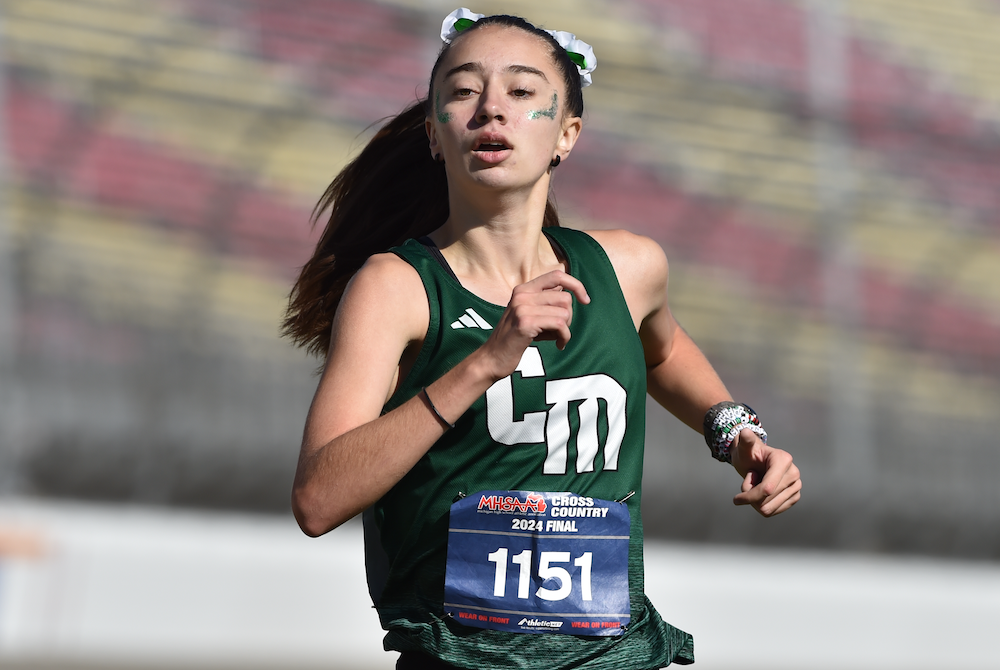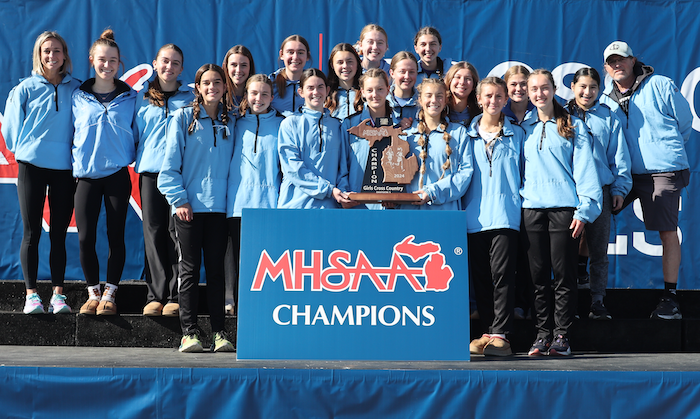
Central Montcalm's Hoffman Pulls Away, Lansing Catholic Claims Close Race
November 2, 2024
BROOKLYN — Kyah Hoffman was winning cross country races for the first four weeks of the season, but wasn’t satisfied with her performances.
As much as coaches stress that it’s place, not time, that matters in cross country, kids are still motivated by lowering their personal records.
Through six meets, Hoffman won five times — taking sixth in the Spartan Elite race against mostly Division 1 runners — but her times were nowhere near where she finished her junior year at Central Montcalm.
Her breakthrough moment came Sept. 28 in Shepherd where she took third against another loaded field in 17 minutes, 40.4 seconds, shaving 0.4 seconds off her fastest time from last season.
Hoffman’s confidence was restored.
She would break 18 minutes four more times this season, the last being a 17:31.6 performance which was good for first place in the MHSAA Lower Peninsula Division 3 Final on Saturday at Michigan International Speedway.
Hoffman won 11 of 13 races this season, her fastest time being 17:25.3 on Oct. 19 in the Northern Michigan Meet of Champions.
“It’s been ups and downs,” Hoffman said. “At first, I was super scared because I was like, ‘I haven’t PR’d. I’ve barely reached the 17s. I don’t know if I’m going to PR this year.’ I was so nervous until I ran at Shepherd and broke my record by .4, which is better than nothing, for sure.
“At Cadillac, I bumped that all the way down to 17:25. I was like, ‘Oh, wow, I am improving. It’s not just a fluke. I’m doing well.’ I knew I could do it. I just had to tell myself I could do it and it was going to happen.”
Hoffman made it happen by putting in a surge in the second mile after her and Emmry Ross of Onsted reached the mile mark in 5:38.8. At the two-mile mark, Hoffman’s lead increased to 9.1 seconds over Ross.
From there, it was just a matter of holding it together over the final 1.1 miles. Hoffman wouldn’t let herself feel comfortable, even if spectators near the finish could see she had a large lead.
“To be honest, I thought there was someone behind me the whole time,” said Hoffman, a four-time all-stater who was third in Division 3 last year. “I was like, ‘I didn’t go this far just to get second.’ I wanted it really badly, so after I passed her at the mile I had to get a gap.
 “I can always hear someone being like, ‘Woo, woo! Go so-and-so!’ But they could be a couple ways away from me or they could be screaming early because they see them coming. It’s just a mystery. Somebody at the very end said, ‘You have 60 meters.’ I knew I’ve got this. I might as well just keep dying.”
“I can always hear someone being like, ‘Woo, woo! Go so-and-so!’ But they could be a couple ways away from me or they could be screaming early because they see them coming. It’s just a mystery. Somebody at the very end said, ‘You have 60 meters.’ I knew I’ve got this. I might as well just keep dying.”
The team race was about as close as it gets, with four teams in the hunt heading into the final mile.
Only 23 points separated the top four, with Lansing Catholic emerging from the fray with its second Finals championship by a 136-147 margin over Pewamo-Westphalia. The Cougars were Division 2 champions in 2017.
Central Montcalm was third with 157 points, and Traverse City St. Francis was fourth with 159.
Lansing Catholic became champion after a seventh-place finish last year, despite graduating sixth-place individual Tessa Roe. The Cougars returned four runners from that team and benefited from an infusion of three freshmen who made the varsity lineup.
One of those ninth-graders, Josie Bishop, led the Cougars by placing 20th in 19:01.8. She was the team’s only all-state finisher, but Lansing Catholic got its five scoring runners across the line among the first 38 places in the team race and first 60 overall.
Sophomore Grace Wonch was 32nd in 19:21.0, missing all-state by two places. Junior Frances Melinn was 42nd in 19:43.6, freshman Isabelle Currie 58th in 20:05.3 and sophomore Avery Miller 60th in 20:10.5.
Pewamo-Westphalia had an 11th-place finisher in senior Whitney Werner (18:17.3) and 14th-place finisher in sophomore Alyssa Kramer (18:39.3), but Lansing Catholic had five runners across before the Pirates had four.
PHOTOS (Top) Central Montcalm’s Kyah Hoffman finishes her Division 3 championship run Saturday at Michigan International Speedway. (Middle) Lansing Catholic holds up its team title trophy. (Click for more from RunMichigan.com; top photo by Dave McCauley and team photo by Carter Sherline.)

MHSAA Vault: MIS Rose to Challenges to Host 2020 LP Finals
By
Rob Kaminski
MHSAA benchmarks editor
November 12, 2021
The “MHSAA Vault” features stories from past publications and other documents in the MHSAA Library. This issue takes a look at the MHSAA Cross Country Finals at Michigan International Speedway, which celebrated 25 years in 2020 – although it was an event that nearly didn’t happen last fall …
In 1996, the MHSAA and Michigan International Speedway began a partnership the changed the course of the Lower Peninsula Cross Country Finals – quite literally.
The land in and around the track at Brooklyn would host the Finals for all classes of runners in one place on one day, an annual festival of nearly 2,000 runners competing for the MHSAA’s top honors.
Even skeptics – and there were several among running purists who thought the course was too flat, for example – can’t deny the results.
Finals attendance nearly doubled in that first year, and crowds in excess of 10,000 have enjoyed a day of racing several times, including a record 12,153 in 2011.
Enthusiastic crowds were the norm in recent years, with 11,232 in 2017, and nearly 11,000 in 2018 (10,989) and 2019 (10,873).
In fact, attendance failed to reach at least 8,000 only twice since the move to MIS.
Of course, last year was an exception, when attendance was limited to 1,000 spectators per session due to the COVID-19 Pandemic. Fans also were restricted to the grandstands rather than following the action throughout locations on the course.
To reduce the number of runners in each race, the event was spread over two days, with each Division being run in two separate “sections” with times then combined at the end to determine team and individual champions.
While not ideal, the end result was another year of fantastic efforts at MIS – both from student-athletes and those behind the scenes.
“Even at the last hour, less than a week ahead of the Finals, we were closer to not having the Finals than we were to having them,” said MHSAA Assistant Director Cody Inglis, who coordinates the cross country postseason. “Rumors and challenges of mandated shutdowns, testing and other requirements were being discussed and caused a lot of unknowns. Even at the Regional level, we had schools, Regional courses and hosts shutting down their facilities; we had to relocate four Regionals 48 hours prior to race times. That scenario just could not happen at the Finals level where far more runners and much more travel would be involved.”
Among the many last-minute hurdles was the edict from NASCAR – which owns MIS – that all persons on site be temperature checked upon entry. That meant securing thermometers that were easy to operate in short order, along with personnel necessary to conduct the readings.
The attendance limitations certainly helped to implement the temperature screening, but brought their own issues.
“Limiting spectators was not a popular decision, but it really was the only way to have a race,” Inglis said. “We were taking direction and working with policies and protocols from the MDHHS, the Governor’s office, Lenawee County Health Department, MIS and NASCAR.”
Part of the solution was to utilize the grandstands as a “barrier” between participants and spectators. The reduced number of fans were dispersed over thousands of seats while still allowing them the chance to watch their student-athletes compete.
“It wasn’t the same, it wasn’t easy or perfect, but it was what we had to do to have a race,” Inglis said. “Separating the Finals into two days and different sections also allowed us to spread out the event and limit the number of people on site at any one time. This was a key part of the plan and worked well even though it separated races within a Division.”
The MHSAA, MIS and the cross country community never lost focus of the main goal: a culmination of the season for the student-athletes, who deserved something last year more than ever. And, more than ever, MIS once again displayed its advantage as a venue that could adapt to the fluid nature of the times to pull off the event.
“There were some thoughts of using four different sites, but as we learned during the Regionals, the climate of things was so tenuous from one area of the state to another that we couldn’t be 100-percent certain that there wouldn’t again be last-minute cancelations,” Inglis said. “MIS was wonderful to work and collaborate with, and was the best option to get it done. It was never mentioned once publicly about the possibility of not having the Finals – only how we could best do it under uncharted conditions.”
The moving parts and ever-changing scenarios created more complexity than ever in finalizing a season, but every decision was made with the complete desire to conduct the Finals as close to normal as possible.
“I firmly believe that a finish to the season, no matter the differences in race formatting and fan experience, was something everyone would have taken when the season began in August,” Inglis said.
Indeed, the finish line in Year 25 at MIS might have been the most gratifying of them all.

